Philippine Markets from the Centro Escolar University Book Collection
In the realm of coffee table books I own, this is definitely in the top three.
The truth is that mandatory isolation at home isn’t really far removed from what I normally do. In the half year or so that I’ve actually had full weekends to myself (read as: not working a physical job) most of that time has been spent languidly waking up to make coffee and breakfast, watching my favourite shows, reading, trying to write, and feeling somewhat guilty that I’ve chosen to spend my time indoors while the weather outside is beautiful and upliftingly sunny. Unlike the culturally-driven guilt I’ve worked on shedding in therapy for the last two years, isolation as a social guilt is one I’ll happily embrace.
When I’m at home, I lose myself in books. Philippine Markets is one I can easily get lost in. It is actually kind of like walking through the maze of alleyways in Baguio’s central market - this spread for “Marketing in the Markets” is so accurate. I’d really like to find out whether that faded ‘cauliflower’ sign is still there.
There are many differences, of course, between the world captured in Philippine Markets and what real markets look like in the country today. Not that I would know much about it, as I can probably recall the handful of times I went to the local wet market - the free-for-all, non-airconditioned palengke.
I say this from my experience growing up in a middle-class household, where SM Supermarkets were the place to go on Sunday afternoons. I don’t remember liking the grocery shopping part all that much (except maybe the snack aisle) but I did love tagging along for the fact that virtually all SM Supermarkets had a Potato Corner kiosk right by the entrance - which meant a large order of cheesy fries. Sometimes I’d opt for sour cream and onion flavour (with bits of dried green onion dotting the powder) but cheeto-orange cheese was easily my go-to.
I think this is relevant to a discussion about markets, because how we begin to experience these places as children, tends to stick with us through adulthood. For me, going to the market meant shopping for food for one week at a time, often with my mom, making our groceries fit a set budget. I used to LOVE cutting out recipes from magazines and pasting them into sheets I could slide into a binder. There was a lot that featured gooey Quickmelt cheese. My favourite was probably a recipe for a “personal pan pizza” (after the popular Shakey’s menu item) that called for a pack of Tender Juicy hotdogs, one can of tomato sauce, and a bar of shelf-stable yellow cheese. All I needed to stay busy for five afternoons at home during my summer vacations.
Perhaps that’s why I find this book so appealing. Yes, I did grow up in the Philippines, but my experience of going to markets is nothing at all like what’s described in the book.
The things I ate at the markets I grew up visiting were nothing like the regional delicacies you can still find in places like Iloilo, Cebu, or Davao today. I think about how those cities have SM Supermarkets too, but I’d venture to say a number of its middle-class adults likely had a similar experience to mine, growing up with societal and cultural preferences that embedded air-conditioned shopping as ‘superior’ to visiting a local wet market. Many reasons aside, I do think now that we lose a significant part of our intangible heritage, the longer we delay understanding the real role of markets in our society today.
Wouldn’t you want to visit one of these markets?







